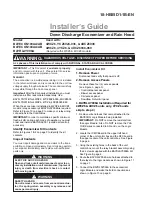
7 Commissioning
Installer reference guide
19
(A)RXP20~3 RXF20~35A2V1B
R32 split series
4P513661-2 – 2017.11
Wire type
Installation method
Single-core wire
c b
c
a
a
A
AA´
A´
a
Curled single-core wire
b
Screw
c
Flat washer
Stranded conductor
wire with round
crimp-style terminal
c b
b
a
c
a
B
B
a
Terminal
b
Screw
c
Flat washer
O
Allowed
X
NOT allowed
Tightening torques
Item
Tightening torque (N•m)
M4 (X1M)
1.2~1.5
M4 (earth)
▪ If single-core wires are used, be sure to curl the end of the lead.
Improper work may cause heat or fire.
▪ The earth wire between the pull relief and the terminal must be
longer than the other wires.
6.7.4
Specifications of standard wiring
components
Component
Power supply cable Voltage
220~240 V
Phase
1~
Frequency
50 Hz
Wire sizes
MUST comply with
applicable legislation
Interconnection cable
(indoor↔outdoor)
4-core cable ≥1.5 mm² and
applicable for 220~240 V
Recommended field fuse
16 A
Earth leakage circuit breaker
MUST comply with
applicable legislation
6.7.5
To connect the electrical wiring on the
outdoor unit
1
Remove the service cover. See
.
2
Strip insulation (20 mm) from the wires.
a
b
a
Strip wire end to this point
b
Excessive strip length may cause electrical shock or
leakage.
3
Open the wire clamp.
4
Connect the interconnection cable and power supply as follows:
3×
5
Tighten the terminal screws securely. We recommend using a
Phillips screwdriver.
6
Install the switch box cover.
7
Install the service cover.
6.8
Finishing the outdoor unit
installation
6.8.1
To finish the outdoor unit installation
1
Insulate and fix the refrigerant piping and interconnection cable
as follows:
f
b
a
e
d
c
a
Gas pipe
b
Gas pipe insulation
c
Interconnection cable
d
Liquid pipe
e
Liquid pipe insulation
f
Finishing tape
2
Install the service cover.
6.8.2
To close the outdoor unit
NOTICE
When closing the outdoor unit cover, make sure that the
tightening torque does NOT exceed 4.1 N•m.
1×
2
1
1
7
Commissioning
7.1
Overview: Commissioning
This chapter describes what you have to do and know to
commission the system after it is installed.
Typical workflow
Commissioning typically consists of the following stages:
1
Checking the "Checklist before commissioning".
2
Performing a test run for the system.










































